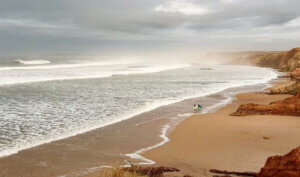Surfing is incredibly fun. For beginners, however, it can seem intimidating, what with all the gear, equipment, and surf jargon to learn. Don’t get me started on the steep learning curve: you always learn something even after years of surfing.
As with all new things, getting started is the hardest part. Once you get going, it does get easier, you can count on that. With adequate preparation and a winning attitude, you’ll be riding the waves in no time.
Here are seven essential beginner surfing tips to help you catch your first wave.
- 1 Choose the right gear
- 2 Find the right surfboard for learning
- 3 Get the right accessories (you might already have some of them)
- 4 Learn the surfing etiquette
- 5 Pick the right surf spot for learning the basics
- 6 Do you want to learn faster? Opt for a surfcamp
- 7 Tips for building your strength and endurance
- 8 Final thoughts
Choose the right gear
First things first: you must invest in the proper gear, there’s no two ways about it. Surfing is a lifestyle (please, don’t buy yourself a pair of Vans yet) plus the most important is that you’ll be spending a lot of time in the water. To get the most out of your experience, you’ll need a high-quality wetsuit that’s snug, not tight—there’s a difference. It’s all about comfort when you hit the waves.
How to choose a wetsuit
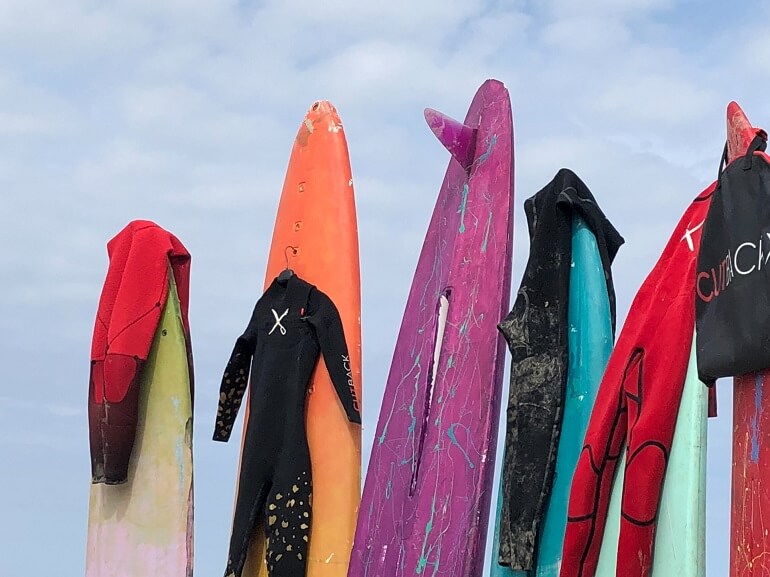
The price of a OK quality wetsuit vs a PROPER one won’t be that much of a difference if you find a good deal, but it will make a difference in terms of comfort.
But how do you know if a wetsuit is a proper wetsuit?
Buzzwords to look for when choosing the best wetsuit include things like:
- reinforced knee pads
- front zipper (avoid having the zipper in the back, you will hate it aftere 2 sessions, trust me)
- sealed seams
- durable neoprene spandex
Those are must-have features in any proper surfing wetsuit.
The difference between normal vs good quality wetsuit
When I first started surfing years ago I had the best wetsuit you can find on Decathlon (big sports equipment stores in Europe), and I thought it was doing a great job. However, I didn’t know that the best one from Decathlon was a step or two behind a proper wetsuit from other brands. Yes, I didn’t have a clue about wetsuits as you can see ✌🏻
The day I tried a 4/3 mm wetsuit from Rip Curl I understood the difference between OK quality and high quality on a wetsuit: it was way more flexible and stretchy.
- I was able to move with more freedom and I felt less “compressed” or encapsulated inside of it
- It helped me paddle easily (less effort to move my arms) and it felt better in general
- Bending my knees and moving my back, upper body and core while doing turns became easier too with this wetsuit, mainly because the fabric was less rigid and I could move my body more freely
So please, get a proper wetsuit (it can be a second hand one, as I explain below).
How to choose the thickness
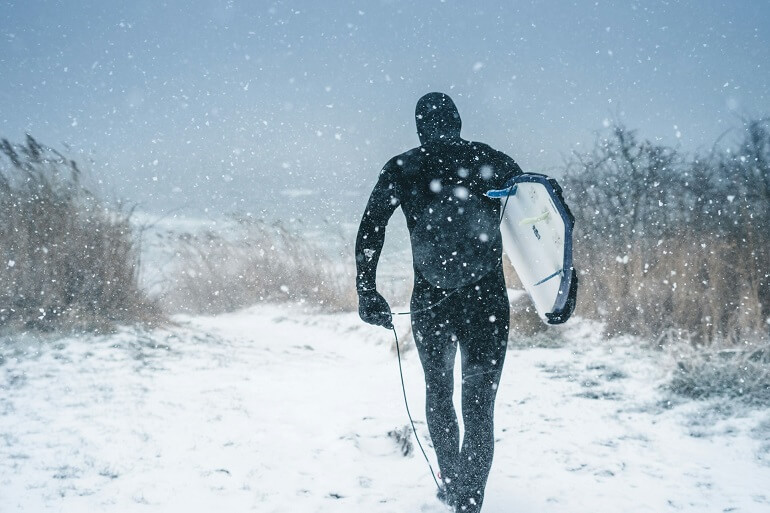
You also need to consider its thickness.
For temperate to cold waters like Atlantic or Pacific oceans around 40º north and 40º south from the equator, the most used wetsuit thickness are 4/3mm and 5/4 mm. With this thickness you can be sure you will be comfortable in the water also during winter sessions. Some people are OK with just a 4/3, if you are more sensitive to cold temperatures maybe is a good idea to go for a 5/4mm.
If you live in very northern or southern latitudes (Canada, Northern Europe, South of Chile or Argentina, southern New Zealand…) you may need an even thicker wetsuit, plus gloves and shoes specifically for cold water.
For hot waters such as the Caribbean, Indian Ocean or equatorial regions in general no wetsuit at all or a shorty wetsuit will probably be enough.
Do you need surf shoes?
It depends. Some people hate surf shoes (especially the split toe ones 🖖🏻) and on the other hand some people can’t get in the water without them.
I would recommend getting shoes if the area or spot where you want to start is rocky. Be aware that during the first few days of your beginner surfing experience you will be walking a lot in shallow water practicing the stand-up technique, so it is probably a good idea to get surf shoes with your wetsuit. Your decision.
How to find surf equipment at a good price
If you don’t want to spend the money on brand new surf equipment, it’s easy: check online for used gear (Craigslist, Facebook Marketplace… whatever works in your area). There’s always someone selling surf gear they don’t use that might be just what you need.
Another thing that has worked for me is to ask around at the end of the season at surf schools. Sometimes they want to get rid of used equipment that is still in good condition, and they are eager to sell stuff at a very good price. Surf shops also have stuff on discount when the season is over.
Same logic around used surf equipment applies to the surfboard (next section).
Find the right surfboard for learning
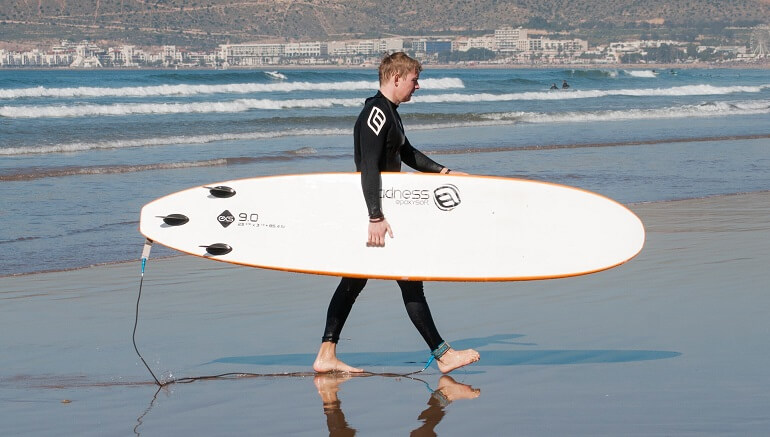
Next, you need to find a solid beginner surfboard. This is arguably one of the most important decisions you’ll make as a newbie, because getting a proper board will speed up the learning process a lot.
A beginner board will help you learn the surf basics faster, and you will be able to move to a intermediate hard-top board with the basic knowledge already learnt within a few days or weeks in the water.
A softboard with big volume is your best friend to learn surfing
Softboards are, no doubt, the most beginner-friendly surfboards you’ll find. Leave the shorter boards to the pros—for now.
But what is a softboard?
Softboards are surfboards that have a padded coating on the deck, a kind of foam that makes them a little bit cushioning. That’s why softboards they are also called “foamies” or “soft tops”.
The bottom is also plastic (not padded), and it’s all glued together around a polystyrene core with two or more stringers inside.
There are tenths of designs for softboards (including performance softboards), but in the case of beginner surfing you want to look for a softboard that has these two main qualities:
- The size of the board (you want to look for big boards)
- The volume (in liters) of the board must be high
How do you choose?
- About the size
- Something between 7′ and 9′ (feet) tall will work like a charm, depending on you height and weight
- About the volume
- Use your weight in kilos as a reference and convert it directly to liters
- So if your weight is 70kgs -> think about 70 liters
- Choose a softboard that is aproximately +/- 8 liters of your weight in liters, so for those 70 liters something like 62 to 78 liters
Note that the two variables above (size and liters) go together: a bigger board will have more liters and vice versa. Manufacturers and shapers play with volume and size all the time, but we won’t get too technical about it for now (maybe in another article).
Why are big softboards the best for beginner surfing? Bigger surfboards:
- Have excellent stability compared to short boards
- The movements they make are slower (so you can feel more in control of it)
- A big volume makes them float easier
So yes, a beginner’s softboard is perfect for learning how to balance and pop up on the wave because it floats a lot and surfs even at low speeds, allowing you to easily catch your first lazy waves and white washes.
Epoxy Core Softboard: the best choice within the softboard range
There are a few types of beginner softboards, and from outside they will look all the same to the untrained eye. However, you want to choose the best in terms of performance and durability.
The best softboard in terms of stability and stiffness are softboards that have an epoxy resin core. They are also known as “epoxy soft tops” or “epoxy softboards”.
This is the type of softboard that has the best of a hard board (its rigid and doesn’t flex with your weight) and is very durable.
You may not feel the difference if you have never surfed before, but a cheap soft board will bend (and slow down) as soon as you stand on it. This is known as the “banana effect” because the board loses its shape and bends in the middle (where you stand up). An epoxy soft board won’t suffer from this and will be rigid, so it won’t lose speed.
Softboards are not only for beginners
I love softboards. In fact, that’s the best board to use during summer, when the waves are small and lazy, and getting speed on a shortboard it’s impossible or you have to paddle very hard for it. With a big soft board you will be on the wave easier (bigger boards paddle better).
So my top recommendation when choosing a beginner surfing board would be that you get a good quality softboard to start your beginner surfing journey, and then keep it even if you buy other boards (if you can afford it or have space at home for more than one board).
Trust me that one year after you started surfing, when you have already a decent intermediate level, you will be happy to have a good quality softboard that allows you to paddle for those lazy and weak summer waves.
The leash
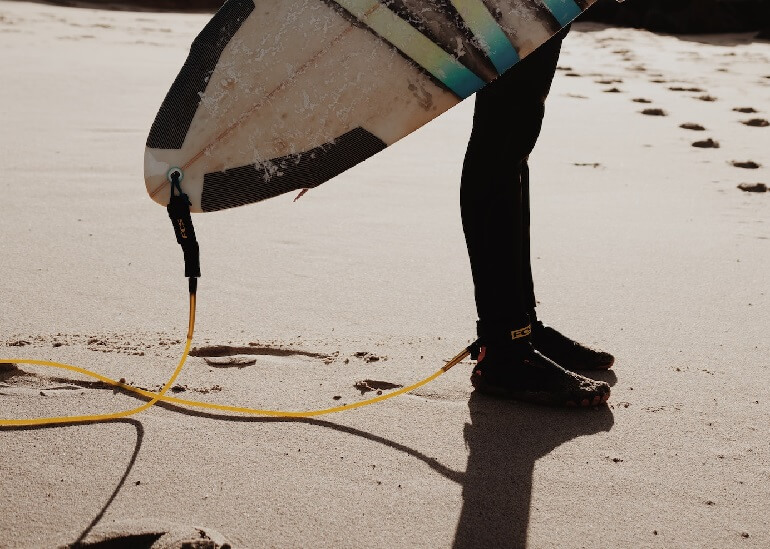
Next, you’ll need a surfboard leash that attaches the board to your ankle. Without it, your surfboard will drift away every time you fall off, at which point you’ll have to chase after it while fighting off the waves.
Usually people sell their used softboards with the leash included, if not any surf shop will have leashes.
The leash length should be at least the same lenght your surfboard is.
Get the right accessories (you might already have some of them)
Once you have your wetsuit and surfboard sorted out, you’re ready to hit the waves, right? Not exactly. You’ll still need some essentials before you embark on your beginner surfing adventure.
Swimsuit
First, probably is a good idea to get a comfortable swimsuit to wear under your wetsuit.
Sure, you could go commando, but it’s always better to have something that creates a barrier between your body and the wetsuit—much for the same reasons we wear underwear underneath our clothes. You can wear a pair of old swim shorts or bikini bottoms you don’t use anymore that won’t ride up under your wetsuit. A rash guard is a safe bet as well.
Sunscreen

You will definitely want sunscreen (please use sunscreen). The sun reflects off the water and sends more radiation to your body and you want to protect yourself from that.
If you are surfing with a wetsuit, facial sunscreen is sufficient. In this case, there are special Zync-based sunscreens for surfers, ask at any surf shop near you.
If you surf on a shortie you can use normal sunscreen for the arms. If you surf without a wetsuit at all, I recommend wearing lycra pants and shirt (so you don’t waste 1 liter of sunscreen per surf session).
I know people who went to the Maldives for a 10 day surf trip just with bikini and shorts (it looks cool in the pictures right?) and got burned so bad they could not go in the water for 3 days in a row. Not a great memory when you cross half the planet just to surf and end up missing half the sessions becasue of a bad sunburnt (plus buying tickets for skin cancer).
Wax
Speaking of falling off (or rather, avoiding falling off), you’ll also need some surf wax to rub on the top of your board.
Surfboards and water are a slippery mix, so waxing the top will keep you from slipping.
Note that with softboards the use of wax can sometimes be avoided, especially for those surfers who don’t turn yet and just use the board to practice standing up and moving straight.
However, in the long run, when you start doing some maneuvers, you will benefit from the extra grip you can get with a waxed board. Any surf shop has wax and it is very cheap.
Learn the surfing etiquette
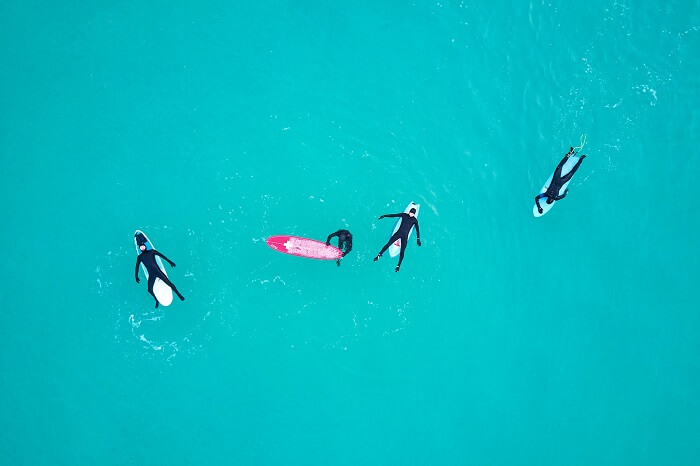
Beginner surfers should familiarize themselves with surfing etiquette.
The surf etiquette are the rules to follow while surfing, that no one tells you about, specially if you are a total beginner, but you must learn for a fun and safe surf experience. These rules are designed to keep everyone safe and ensure mutual respect among surfers is upheld on the water.
And that’s not a rule of the surf etiquette but a common sense rule: always remember that the ocean is a powerful force. Don’t let overconfidence cloud your good sense. Ensure you obey the lifeguards’ instructions, and if there are no lifeguards ask the local surfers. It always looks easier from the outside.
But let’s go check the surf etiquette and rules.
Give right of way
The guy who is more far away in the peak always has priority. In case this surfer does not catch the wave, then the next in the queue can go for it. While waiting, steer clear of other surfers, stay in your own space, and always wait your turn. The worst thing you can do to someone else on the water is steal their wave from them. This one is a major faux pas and should be avoided.
There will always be another surfer waiting for you to ride.
Don’t drop in
Dropping in means that you enter the wave of another surfer while she/he is riding it. In other words: you cross in the trajectory of someone already riding the wave.
That means that this other surfer can’t finish the ride because she/he has to avoid you. In the case of not being able to avoid you, this can lead to a crash. You don’t want to gain a reputation for being the guy that drops in on everyone. Don’t be that person.
Don’t snake
Don’t be the obnoxious surfer who ruins everyone’s day by paddling around everyone to be first in the line. After finishing your ride, paddle back to the peak and queue in the line so the guys that are there waiting catch a before before you. In short: wait for your turn.
Leave space for other surfers
Are you progressing faster than other on your beginner surfing journey? Well, don’t steal all the waves from them. It’s ok to catch some more waves than others if you have the ability to do so, but just don’t take all of them and give everyone a chance.
Apologize when you do things wrong
Sometimes you will drop on someone or break the rules of the surf etiquette. If you, for whatever reason and through no fault of your own, are involved in an incident with another surfer, it costs you nothing to apologize. Keep it low and say sorry.
You probably will like to be aplogized too if someone drops in on you. Being kind to others on the water (and outside) is how you win over new friends and maybe gain some insider pro surfing tips too.
Don’t paddle out through the peak, but around it
When coming back to the line-up, do it safely paddling around it and not through it. If you paddle through the peak you will be on the way of other surfers actually riding the wave, and that means that they have to avoid you while doing their ride (you will ruin their ride).
Help other surfers
If you see someone in trouble, help. Also if you see other surfers breaking the surf etiquette, let them know the safety rules so them and everyone else has a good time in the water.
Surf on spots and conditions that suit your level
If you don’t know the spot or you feel that the waves are too big, probably is a good idea to not go in. Don’t get me wrong, it always feels nice to challenge yourself with waves or conditions that are on the limit of your level (that’s how you progress), but don’t exceed.
Entering a surf spot that is over your level will just piss off other surfers. Also you can hurt yourself and others, and getting injured in the water will stress you and everyone else around you.
Respect the locals
Local surfers know the spots better than anyone, and can give you tips around best tide, swell direction, conditions and hazards you might find. Respect them and they will respect you.
Respect the ocean
Last, don’t polute, pick-up your trash and leave the spot as you found it. If you are using sunscreen please use a specific one for surfers or with Ocean Safe Certified label.
Pick the right surf spot for learning the basics
Once you have everything you need to hit the waves and know about the surf etiquette, the only thing left to do is pick the right surf spot.
As a total beginner you want to find a non-crowded spot with whitewash waves rolling over a shallow area. When I say shallow I mean around 1 meter deep (3 feet). You want to catch as many whitewash waves as possible without getting in the way of the more experienced and advanced surfers.
What is the whitewash?
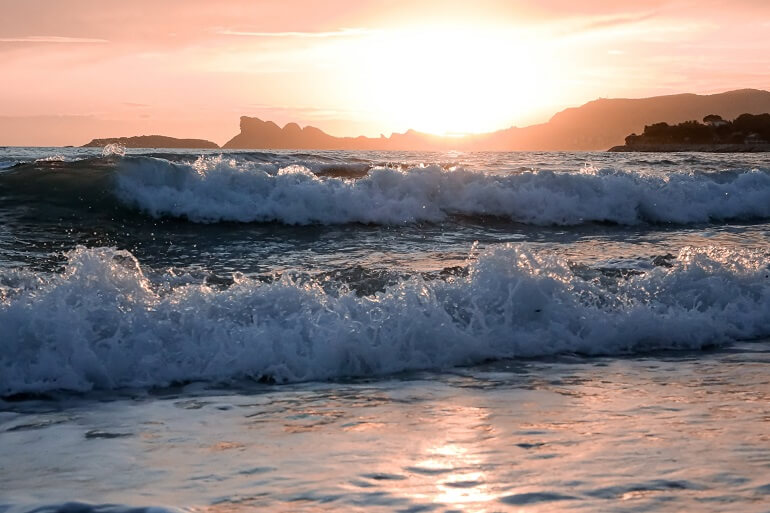
The whitewash is the already broken wave moving towards the shore. The whitewash is perfect for beginner surfing becasue it will push the board and you to gain speed while you are still in shallow water and horizontal position. Whitewash is also slower than the wave it generated it, so it does not feel intimidating if you never surfred before.
The whitewash is the perfect environment to start practicing the paddle and the surf stand-up.
The paddle and stand-up or pop-up
Those are the first two techniques you need to learn:
- how to paddle strong to gain speed
- how to get up on the board quickly
In the beginning you won’t be paddling enough, you will do the stand-up too slow, you will fall, you will not position your feet correctly… well, that’s part of the process.
Explaining the pop-up insights in text might be a bit difficult, so here’s a great video from Barefoot Surf that explains the do’s and don’ts of the pop-up:
Mastering the pop-up is the key to moving from the whitewash to catching green waves, so practice it enough.
Do you want to learn faster? Opt for a surfcamp
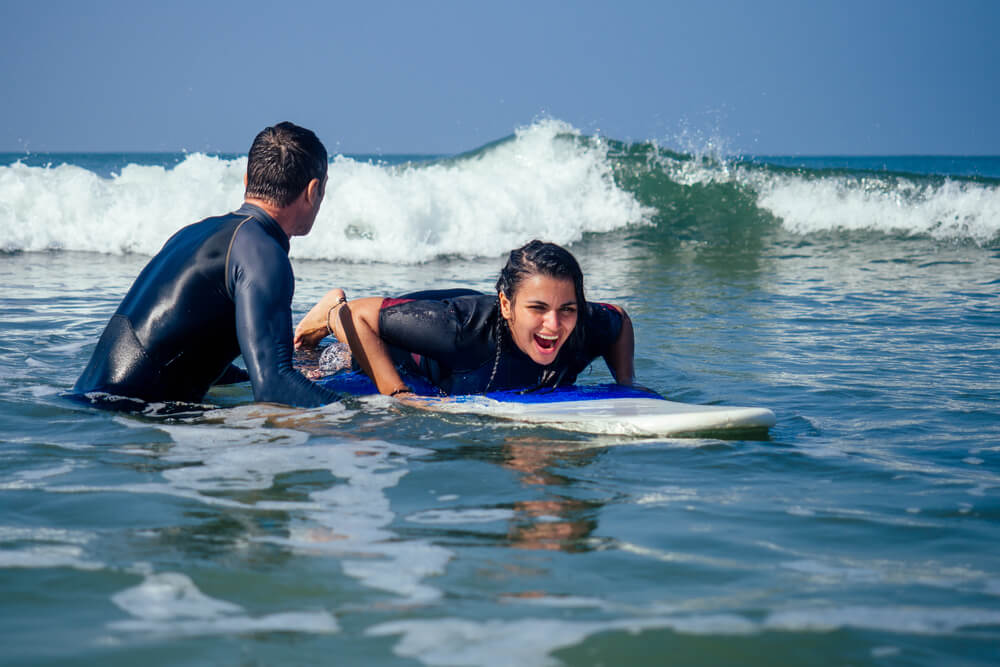
If learning how to surf solo sounds daunting, it might be a good idea to go to a surf camp and enroll in a scheduled surf lesson series for a few days in a row.
Heck, you can even make a vacation out of it. Surf camps have professional instructors who can hold your hand at every step. They’ll show you which waves to catch, how to paddle and ride, how to maneuver your surfboard, and if you are already an intermediate surfer they will even help you correct your form and technique so you can move to a more advanced level.
Joining a surf camp is infinitely more budget-friendly than paying for one-to-one lessons from a coach by yourself. The latter option would mean buying or renting surfing gear and equipment from a surf shop, catering for the transport costs to and from the surfing spots, and paying for a hotel—you get the drift.
At a surf camp, however, the affordable all-in fee you pay for the X number of days you’ll be there takes care of everything.
We’re talking that everything will be included:
- meals
- accommodation
- surf classes
- gear
- equipment
- transportation to and from the surf spot
- hotel amenities
- Sometimes even airport transfers
Some great beginner surf camps worth exploring include the following:
- 5-Day Surf, Yoga, and Adventure Retreat in Hawaii
- 7-Day Amazing Kite Surf Camp in the Dominican Republic
- 7-Day Double Surf Camp in Costa Rica
- 8-Day Insight Yoga and Surf Camp in Mexico
- 8-Day Surf Camp in Panama
Tips for building your strength and endurance
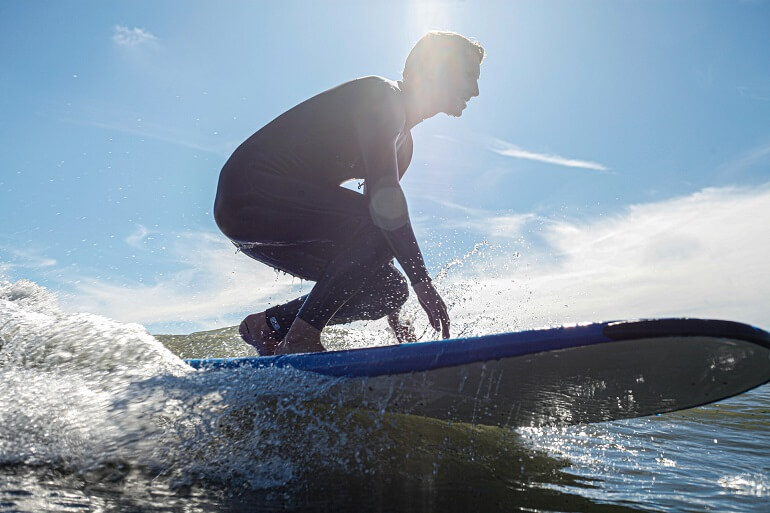
The best way to prepare your body for surfing is to surf as much and as often as you can. But you can also work out at home or at the gym to help you progress faster.
If you are in good shape because you are more active, you already have an advantage over a sedentary person.
Surfing engages the body’s core. Adopting a regular strength training routine is critical. Frequent exercise doesn’t just increase your endurance, it also minimizes the likelihood of injuries out on the water.
Some great strength-training exercises you can focus on include burpees, push-ups, and squats. Their dynamic nature makes them ideal for surfers since they target multiple muscle groups simultaneously. For best results, do these a couple of times a week.
You also want to incorporate crunches, planks, and other strength workouts that target the core. A strong core is the secret to maintaining stability as you ride and maneuver on a wave.
High-intensity interval training (HIIT) is highly effective for building endurance. The short bursts of energy-intensive movements that push your heart rate to the max, followed by shorter rounds of lower-intensity movements, simulate the energy demands of surfing.
If you’ve never tried HIIT, start with something as simple as running. Run flat out for one minute, rest for two, and repeat this sequence seven more times. That should take you roughly 20 minutes, give or take. As your endurance increases, you can increase the duration of the higher-intensity movements and shorten the rest periods between.
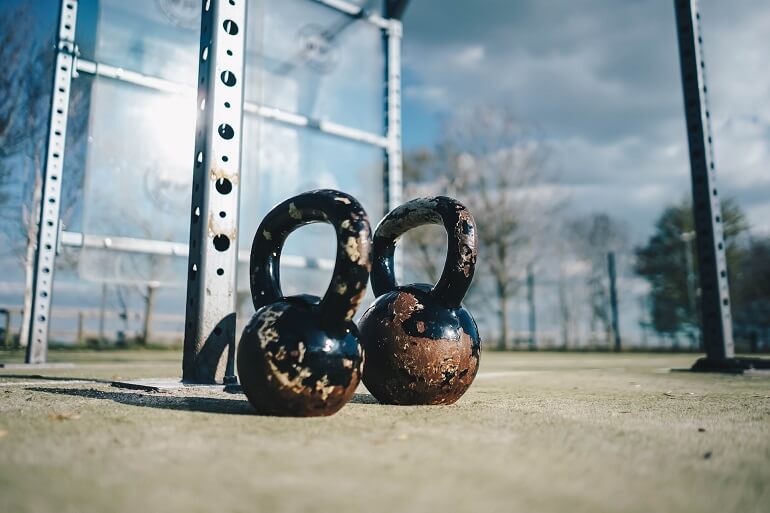
Final thoughts
There you have it. Everything you need to catch your first wave in style. Remember, getting started is the hardest part. You must invest time and raw grit to hone your skills to get to pro-level surfing one day. The tips in this guide should help point you in the right direction.
Go on, chase those waves, and show ’em who’s boss!
In the meantime, have you explored Mexico’s rich surfing culture?
Learn why it’s such a popular surfing destination for wave chasers worldwide.




